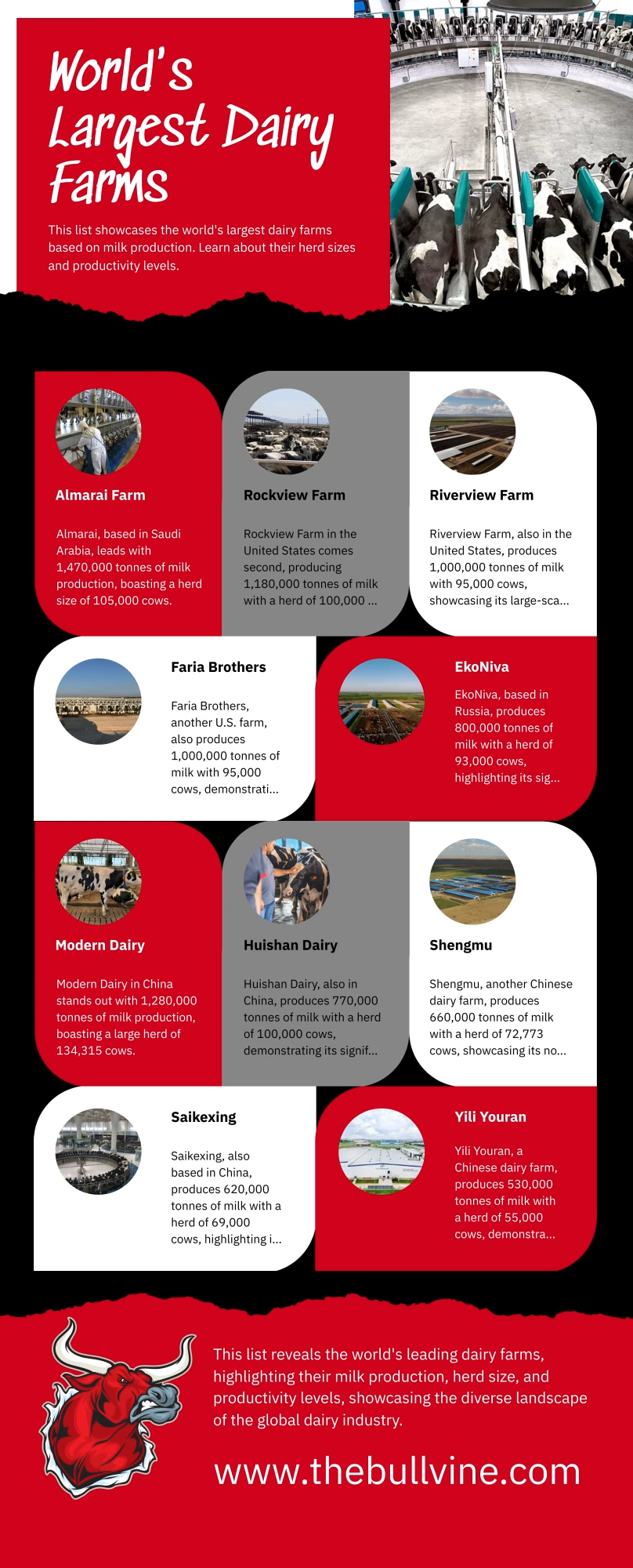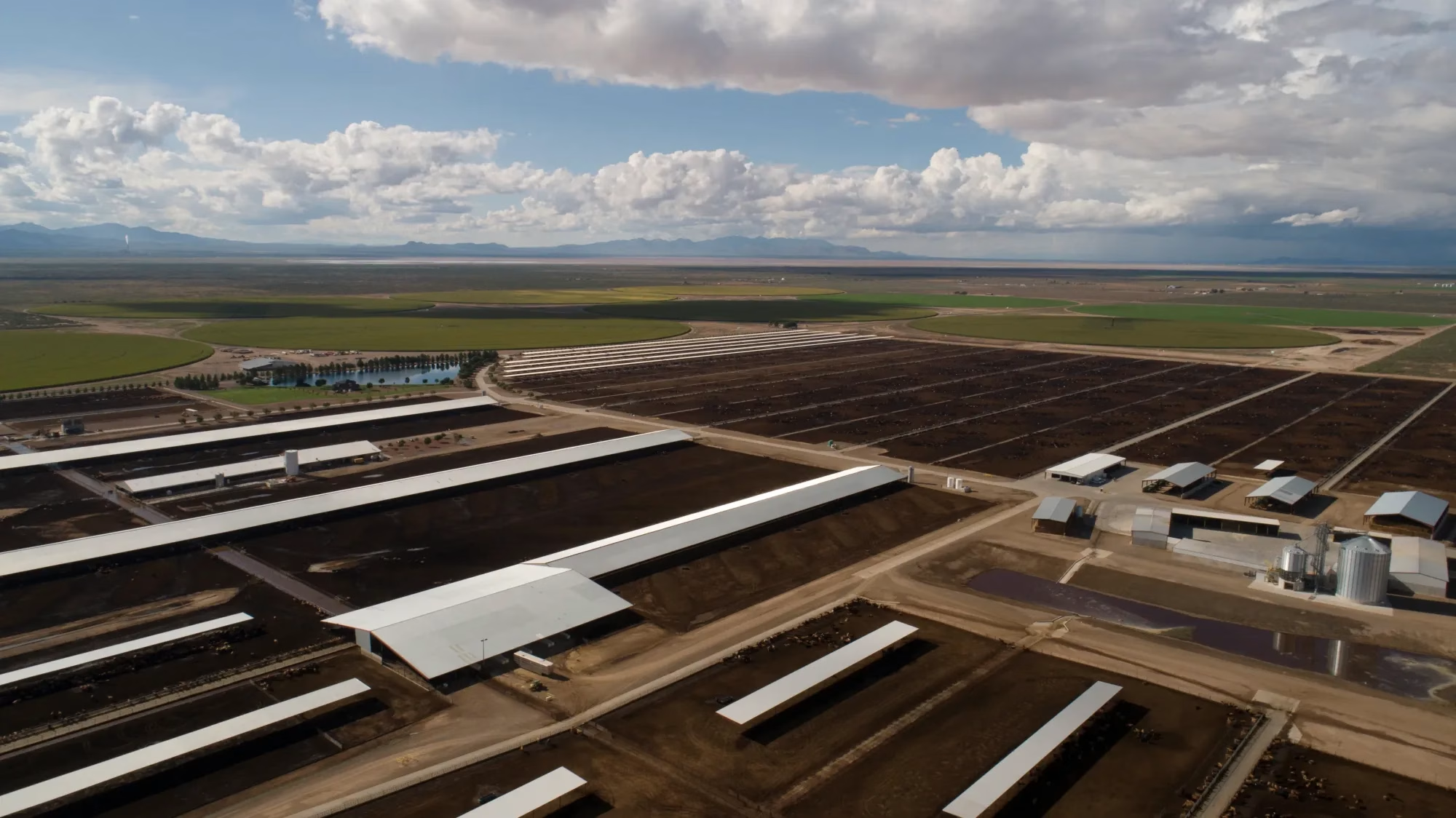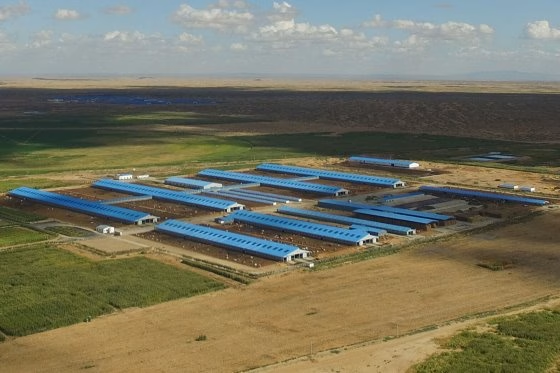Dive into the world of mega-dairies, where a single farm can fill an Olympic pool with milk daily. Discover how these giants are reshaping global dairy production.
EXECUTIVE SUMMARY: This article explores the world’s top 10 largest dairy farms, revealing how these mega-operations transform the global dairy industry. From Saudi Arabia’s desert-defying Almarai to China’s distributed Modern Dairy, these farms produce staggering volumes of milk, with some exceeding 1 million tonnes annually. The analysis highlights the geographic shift in dairy production, with China dominating the list, followed by the United States. Key factors driving their success include economies of scale, advanced technologies, and innovative management practices. The article also examines farm productivity differences, showcasing how efficiency varies across regions and operational models. While these mega-dairies represent the future of large-scale milk production, they also face unique challenges in sustainability, animal welfare, and community relations.
KEY TAKEAWAYS
- The world’s 10 largest dairy farms account for 1.1% of global milk output, with individual farms producing up to 1.47 million tonnes annually.
- China leads with five of the top 10 farms, reflecting its strategic push for domestic milk production and food security.
- Productivity per cow varies significantly, with Saudi Arabian and U.S. farms achieving higher efficiency than their Chinese and Russian counterparts.
- Mega-dairies leverage advanced technologies, vertical integration, and strategic locations to maximize production and efficiency.
- While offering lessons in scale and efficiency, these operations also face unique challenges in waste management, animal welfare, and environmental impact.

What if a single dairy farm could produce enough milk to fill an Olympic-sized swimming pool daily? Welcome to the world of mega-dairies, where scale defies imagination and efficiency reaches new heights.
These mammoth enterprises are reshaping our understanding of dairy production, pushing the boundaries of what’s possible, and setting new standards for an industry that feeds billions worldwide.
The Billion-Liter Club: Meet the Dairy Giants Transforming Global Production
The trend towards more significant, concentrated dairy operations has been gaining momentum for decades. According to the International Farm Comparison Network (IFCN), the world’s ten largest dairy farming companies account for approximately 1.1% of global milk output.
While this may seem small, it represents a significant concentration of production capability and highlights the growing importance of large-scale operations in meeting global dairy demand.
Dr. Torsten Hemme, Managing Director of the IFCN, explains: “The economies of scale in dairy farming are undeniable. Larger operations can invest in advanced technologies, implement more efficient management practices, and negotiate better prices for inputs and outputs.”
As we examine the world’s dairy giants, the following table provides a comprehensive overview of these operations, allowing for a direct comparison of their scale, geographic distribution, and distinctive characteristics. These numbers tell a powerful story about how milk production is evolving in the 21st century.
| Rank | Farm Name | Country | Annual Milk Production (million tonnes) | Herd Size | Key Feature |
| 1 | Almarai | Saudi Arabia | 1.47 | 105,000 | Desert dairy success |
| 2 | Modern Dairy | China | 1.28 | 134,315 | Distributed across 26 locations |
| 3 | Rockview | United States | 1.18 | 100,000 | Vertical integration |
| 4 | Riverview | United States | 1.00 | 95,000 | Diversified operations |
| 5 | Faria Brothers | United States | 1.00 | 95,000 | Texas-based efficiency |
| 6 | EkoNiva | Russia | 0.80 | 93,000 | Europe’s largest, fastest growing |
| 7 | Huishan Dairy | China | 0.77 | 100,000 | Complete supply chain control |
| 8 | Shengmu | China | 0.66 | 72,773 | Organic focus |
| 9 | Saikexing | China | 0.62 | 69,000 | Strategic Inner Mongolia location |
| 10 | Yili Youran | China | 0.53 | 55,000 | Processor-owned operation |
China’s Dairy Dominance: How the East is Reshaping Global Milk Production
Interestingly, the geographic distribution of these mega-farms reflects regional differences in approaches to dairy production. China dominates the list with five of the world’s ten most extensive dairy farming operations, while the remainder are spread across Saudi Arabia, the United States, and Russia.
Dr. Jennifer Spencer, Extension Dairy Specialist at Texas A&M University, offers insight into this distribution: “China’s heavy investment in large-scale dairy farms is part of a broader strategy to increase domestic milk production and reduce reliance on imports. In contrast, countries like the United States have a mix of large operations and smaller family farms, reflecting different agricultural traditions and market structures.”
Inside the Milk Machines: The World’s Dairy Goliaths
Let’s dive into the details of these dairy giants, exploring what makes each unique and how they’ve achieved their impressive scale.
Almarai: The Desert Dairy Miracle That Tops the Global Charts

Almarai, the Saudi Arabian dairy powerhouse founded in 1977, is at the top of the list. With an annual production of 1.47 million tonnes of raw milk and a herd of approximately 105,000 dairy cows, Almarai has established itself as the world’s largest dairy farm by milk volume.
Almarai’s success in a desert environment not naturally conducive to dairy farming is particularly remarkable. To overcome these challenges, the company has invested heavily in advanced cooling systems, water conservation technologies, and feed production.
Abdullah Al-Otaibi, Almarai’s Head of Dairy Operations, explains: “Our success is built on a combination of cutting-edge technology, stringent quality control, and a deep understanding of our unique operating environment. We’ve turned the challenges of desert farming into opportunities for innovation.”
Modern Dairy: China’s Distributed Dairy Giant with the World’s Largest Herd

While ranking second in milk production with 1.28 million tonnes annually, Modern Dairy boasts the world’s largest dairy herd, with 134,315 cows spread across 26 locations in seven Chinese provinces.
Dr. Li Wei, an agricultural economist at China Agricultural University, notes: “Modern Dairy’s distributed model allows them to optimize logistics and market access across China’s vast geography. This strategy is particularly well-suited to China’s rapidly expanding dairy market.”
Rockview: America’s Vertically Integrated Dairy Pioneer

California-based Rockview, owned by the DeGroot family, produces approximately 1.18 million tonnes of raw milk annually from its herd of about 100,000 dairy cows. Founded in 1927, Rockview Family Farms has distinguished itself as one of the last dairies in Southern California to maintain control over all stages of production, from the cow to the customer.
Ted DeGroot, CEO of Rockview, emphasizes the importance of vertical integration: “By controlling every step of the process, we can ensure the highest quality standards while also adapting quickly to market changes. It’s a model that’s served us well for nearly a century.”
Riverview: Minnesota’s Multi-Species Agricultural Powerhouse

Based in Minnesota, Riverview is owned by the Fehr family and produces approximately 1.00 million tonnes of raw milk annually from its 95,000 dairy cows. The operation has expanded beyond dairy to include beef and crop production and milk processing facilities.
Dr. Marin Bozic, Associate Professor in Dairy Foods Marketing Economics at the University of Minnesota, comments on Riverview’s diversified approach: “By integrating dairy, beef, and crop production, Riverview has created a more resilient business model. This diversification helps manage risk and maximize resource utilization.”
Faria Brothers: Texas-Sized Efficiency in Dairy Production

Texas-based Faria Brothers matches Riverview with 1.00 million tonnes of annual milk production and approximately 95,000 dairy cows. The Faria family has built this operation into one of America’s largest dairy farms, benefiting from Texas’s favorable conditions for large-scale agricultural operations.
Dr. Jennifer Spencer of Texas A&M University notes: “The Faria Brothers’ success demonstrates the advantages of scale in modern dairy farming. Their size allows them to implement advanced technologies and management practices that would be cost-prohibitive for smaller operations.”
EkoNiva: Russia’s Rapidly Growing Dairy Revolution

Founded by Stefan Dürr, EkoNiva is Europe’s largest raw milk producer and the fastest-growing company on the top 10 list. Based in Russia’s Voronezh region, the operation produces approximately 0.80 million tonnes of raw milk annually from its 93,000 dairy cows.
Dürr attributes EkoNiva’s rapid growth to several factors: “We’ve benefited from Russia’s push for agricultural self-sufficiency, coupled with our focus on efficiency and vertical integration. Our goal is to control quality at every stage of production.”
Huishan Dairy: China’s Supply Chain Control Specialists

Led by Yang Kai, Huishan Dairy operates primarily in China. Its herd of approximately 100,000 dairy cows produces 0.77 million tonnes of raw milk annually. The company has expanded its operations to include feedstuff production and liquid milk and milk powder manufacturing.
Dr. Jiaqi Wang, a researcher at the Chinese Academy of Agricultural Sciences, explains the significance of Huishan’s vertical integration: “After several food safety incidents in China’s dairy industry, companies like Huishan have prioritized controlling the entire supply chain. This approach helps ensure quality and rebuild consumer trust.”
Shengmu: Proving Organic Can Scale in China’s Dairy Industry

Based in Deng Kou County, China, and founded by Tongshan Yao, Shengmu focuses on organic dairy production. With approximately 72,773 dairy cows, the operation produces 0.66 million tonnes of raw milk annually.
Yao explains the company’s organic focus: “We recognized growing demand for organic dairy products early on, even in emerging markets like China. By operating at scale, we can make organic production more efficient and accessible.”
Saikexing: Leveraging Inner Mongolia’s Natural Advantages

Yang Wenjun serves as Board Chairman of Saikexing, Which operates in Inner Mongolia, China. The farm produces approximately 0.62 million tonnes of raw milk annually from its herd of 69,000 dairy cows.
Dr. Yuelai Lu, a researcher at the UK-China Sustainable Agriculture Innovation Network, comments on Saikexing’s location strategy: “By situating their operations in Inner Mongolia, Saikexing takes advantage of the region’s extensive grasslands and relatively favorable conditions for dairy farming within China. It’s a smart approach to resource management.”
Yili Youran: How Processors Are Becoming Producers

Rounding out the top 10 is Yili Youran, led by Board Chairman Pan Gang. This Chinese operation produces approximately 0.53 million tonnes of raw milk annually from its 55,000 dairy cows.
As part of the larger Yili Group, which ranks among the world’s largest dairy companies by revenue, Yili Youran represents the integrated approach many Chinese dairy processors have taken to secure their supply chains.
Dr. Shengli Li, Professor of Animal Science at China Agricultural University, explains: “Yili’s investment in its farming operations reflects a broader trend in China’s dairy industry. By controlling milk production, processing companies can better manage quality and supply stability.”
Production Champions: Who Produces the Most Milk Per Cow?
Looking beyond raw production numbers, the efficiency of these operations tells another important story. The following table breaks down productivity per cow across the top 10 farms, revealing significant variations in efficiency that often correlate with management practices, technology adoption, and regional conditions.
Note how the highest productivity doesn’t always align with the most significant total production.
| Farm Name | Country | Milk Production (tonnes) | Herd Size | Productivity (tonnes/cow/year) |
| Almarai | Saudi Arabia | 1,470,000 | 105,000 | 14.00 |
| Rockview | United States | 1,180,000 | 100,000 | 11.80 |
| Riverview | United States | 1,000,000 | 95,000 | 10.53 |
| Faria Brothers | United States | 1,000,000 | 95,000 | 10.53 |
| EkoNiva | Russia | 800,000 | 93,000 | 8.60 |
| Modern Dairy | China | 1,280,000 | 134,315 | 9.53 |
| Huishan Dairy | China | 770,000 | 100,000 | 7.70 |
| Shengmu | China | 660,000 | 72,773 | 9.07 |
| Saikexing | China | 620,000 | 69,000 | 8.99 |
| Yili Youran | China | 530,000 | 55,000 | 9.64 |
The productivity data reveals a fascinating pattern: farms in Saudi Arabia and the United States consistently achieve higher output per cow than their counterparts in China and Russia.
This disparity reflects differences in feeding regimes, genetic selection, management practices, and technological implementation—all factors dairy producers worldwide can learn from when seeking to improve their operations.
The Unstoppable Growth: Will Mega-Dairies Dominate Tomorrow’s Milk Market?
As we look to the future, the trend towards more significant, more efficient dairy operations shows no signs of slowing. Dr. Torsten Hemme of the IFCN predicts: “We expect to see continued consolidation in the dairy industry, with the most efficient operators growing larger and potentially new entrants disrupting the market with innovative approaches.”
However, this trend is not without its challenges. Dr. Jennifer Spencer of Texas A&M University cautions: “While large-scale operations can achieve impressive efficiencies, they also face unique challenges in waste management, animal welfare, and community relations. Successful mega-dairies will need to address these issues proactively.”
Scaling Success: What Every Dairy Producer Can Learn from the World’s Largest Farms
The world’s largest dairy farms represent a significant evolution in global food production. They showcase how scale and efficiency can help meet the nutritional needs of a growing population.
From Almarai’s desert-defying success in Saudi Arabia to Modern Dairy’s massive herd spread across multiple Chinese provinces, these operations demonstrate different approaches to the common challenge of large-scale milk production.
As the global dairy industry evolves, these leading operations will likely remain at the forefront of innovation and productivity. Their influence extends far beyond their direct output, shaping industry practices, driving technology adoption, and setting new standards for efficiency.
The rise of mega-farms offers both challenges and opportunities for dairy farmers worldwide. While competing directly with operations of this scale may not be feasible for many, valuable lessons about efficiency, technology adoption, and strategic planning can benefit farms of all sizes.
As we progress, the key for all dairy operations, regardless of size, will be to focus on sustainability, efficiency, and adaptability. By embracing innovation while respecting the timeless principles of good animal husbandry and environmental stewardship, the dairy industry can continue to thrive and meet the world’s growing demand for nutritious dairy products.
LEARN MORE
- Riverview Dairy’s Massive Expansion: A Death Knell for Small Dairy Farms?
- Minnesota Dairy Giant: Discover the Secrets Behind Milking 9500 Cows Daily
- Discover How U.S. Cows Are Shattering Milk Production Records
 Join the Revolution!
Join the Revolution!
Join over 30,000 successful dairy professionals who rely on Bullvine Daily for their competitive edge. Delivered directly to your inbox each week, our exclusive industry insights help you make smarter decisions while saving precious hours every week. Never miss critical updates on milk production trends, breakthrough technologies, and profit-boosting strategies that top producers are already implementing. Subscribe now to transform your dairy operation’s efficiency and profitability—your future success is just one click away.







 Join the Revolution!
Join the Revolution!



